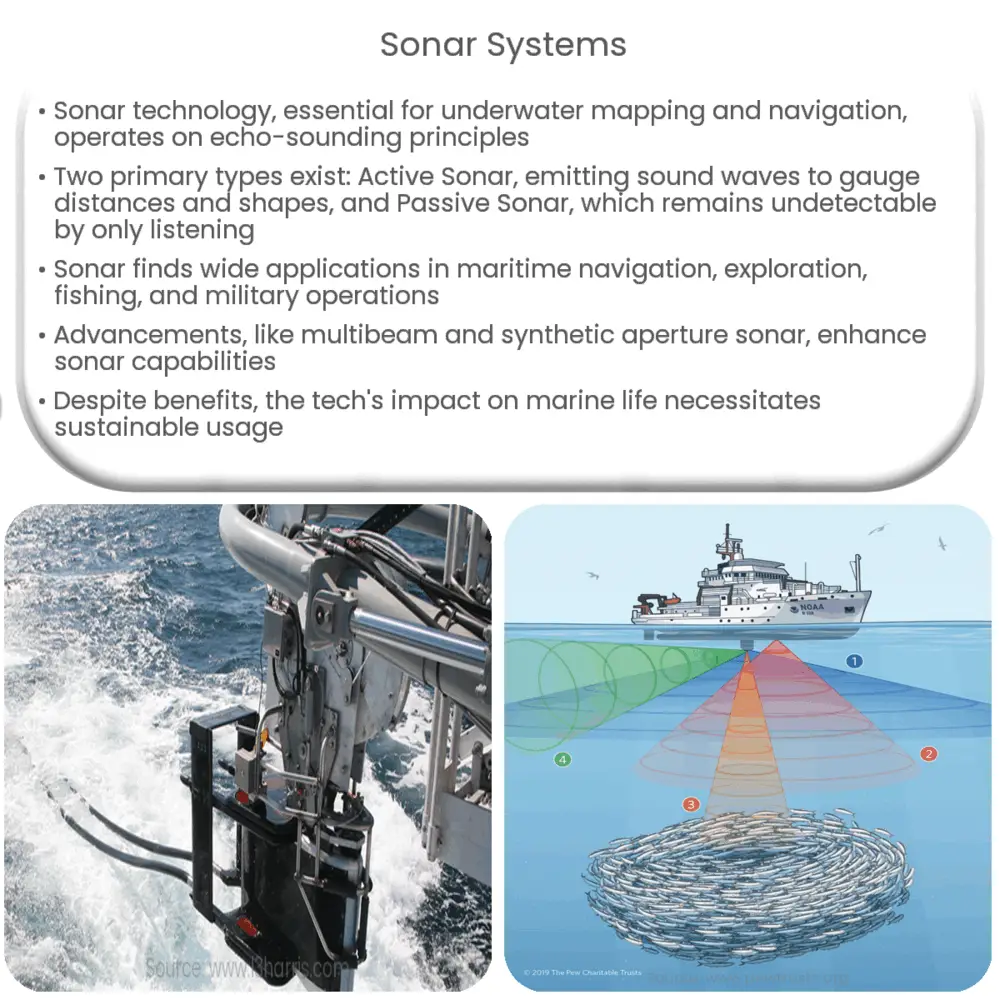Explore the world of Sonar Systems: understand their working, types, applications, advancements, and their environmental impact.

Sonar Systems: An Overview
The world of navigation and underwater exploration has been revolutionized by a technology known as Sonar. Sonar, an acronym for Sound Navigation and Ranging, is an essential tool for mapping underwater environments, navigating, and detecting objects beneath the surface of the water. This article will delve into the workings of sonar systems, their applications, and the important role they play in numerous fields.
Working Principle of Sonar Systems
Sonar systems work on the principle of echo-sounding, very much akin to echolocation used by animals like bats and dolphins. The system transmits sound waves, which travel through the water, bounce off objects, and then return to the source. By calculating the time it takes for the echo to return, the system can determine the distance to the object. This principle can be summarized in two steps:
- Transmission of the sound wave
- Reception of the echo
Types of Sonar Systems
Sonar systems are classified into two primary types: Passive and Active.
- Active Sonar: These systems actively emit sound waves. By interpreting the returned echo, they can infer the distance, size, and shape of objects or obstacles underwater. However, the active sonar system can give away its location due to its emission of sound.
- Passive Sonar: Passive sonar systems do not emit any sound waves. Instead, they listen to the sounds produced by other objects in the water. These systems are ideal for stealth operations as they do not reveal their location.
Applications of Sonar Systems
Sonar systems find wide applications in various fields. They are invaluable for maritime navigation, underwater exploration, fishing, and military operations.
- Maritime Navigation: Sonar systems provide crucial data about the sea floor, helping in charting safe courses for vessels and avoiding underwater hazards.
- Underwater Exploration: They are pivotal in geological research, facilitating the mapping of underwater topography, and in the exploration of sunken ships, or in search and rescue operations.
- Fishing: Sonar systems help in identifying fish schools and determining their depth and size, proving invaluable to commercial fishing.
- Military Operations: They play a key role in submarine navigation and detection, mine detection, and various other naval activities.
The versatility and precision of sonar systems underscore their importance. In the following sections, we will delve deeper into their intricacies and understand how advancements are shaping the future of this technology.
Advancements in Sonar Technology
As technology continues to evolve, so does sonar. Cutting-edge advancements are being incorporated into sonar systems to increase their capabilities and efficiency.
- Multibeam Sonar: This type of sonar system emits a fan of sound beams, creating a detailed, high-resolution map of the sea floor. It provides a wider coverage area and more precise imaging compared to traditional single-beam sonar.
- Side-Scan Sonar: This system emits fan-shaped pulses to either side of the device, creating a detailed image of the sea floor. It is highly useful in search and recovery operations and archaeological explorations.
- Phased Array Sonar: A highly advanced system where multiple small sonar transducers work together to generate a focused beam of sound in specific directions. It’s particularly beneficial in military operations for object detection and tracking.
- Synthetic Aperture Sonar: This system combines the long-range capabilities of sonar with high-resolution imaging, providing detailed imagery over large areas. It is ideal for mine detection and underwater archaeology.
Environmental Impact and Future Perspectives
While sonar has proven invaluable in various fields, its impact on marine life has also been a topic of concern. High-intensity sonar pulses may cause disorientation and hearing loss in marine mammals, leading to stranding incidents. Therefore, ongoing research aims to mitigate these adverse effects while maximizing the technology’s benefits.
Conclusion
In conclusion, sonar systems, with their versatility and precision, have become a cornerstone technology in maritime navigation, underwater exploration, and military operations. The continuous advancements in sonar technology promise greater efficiency and more detailed underwater imaging. However, it is also crucial to balance these benefits with the potential environmental impact, ensuring a sustainable future for both our exploration endeavors and the marine ecosystem. The path forward lies in harnessing this powerful technology while also being stewards of the aquatic environments in which it operates.

